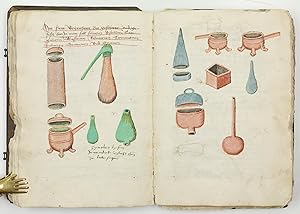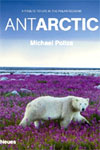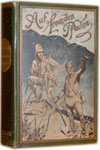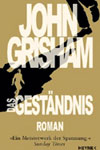An alchemist's handbook, in German. Illustrated manuscript on paper.
[Alchemical manuscript].
Verkäufer
Antiquariat INLIBRIS Gilhofer Nfg. GmbH, Vienna, A, Österreich
Verkäuferbewertung 5 von 5 Sternen
![]()
AbeBooks-Verkäufer seit 22. November 2000
Beschreibung
Beschreibung:
Small 4to (140 x 195 mm). 91 leaves, 149 written pages in two hands, the main body of the text complete, up to 29 lines per page, ruled space 85 x 155 mm. Incipit: "In nomine domini amen. Noch dem also gesprochen ist daß alle kunst kunftigk ist von got und ist by im on ende.". Rubrics touched in red, calligraphic initials in red and some with flourishing, 25 watercolour illustrations of scientific apparatus, 10 mathematical and architectural diagrams in pen. 15th century German calf over wooden boards, tooled in blind with vertical rows of hunting scenes within a triple-filet frame, remains of two fore-edge clasps. Stored in custom-made half morocco clamshell case. A Renaissance alchemist's handbook, quoting Al-Razi by name and deeply rooted in the Islamic tradition of alchemical art. An intriguing manuscript which bears witness to early practical chemistry in 15th century Germany and to the immense influence of Arabic alchemy, illustrated with talented watercolour diagrams of the associated apparatus. - Indeed, the word 'alchemy' itself is derived from the Arabic word 'al-kimia', and it was Al-Razi who claimed that "the study of philosophy could not be considered complete, and a learned man could not be called a philosopher, until he has succeeded in producing the alchemical transmutation". Alchemy and chemistry often overlapped in the early Islamic world, but "for many years Western scholars ignored Al-Razi's praise for alchemy, seeing alchemy instead as a pseudoscience, false in its purposes and fundamentally wrong in its methods, closer to magic and superstition than to the 'enlightened' sciences. Only in recent years have pioneering studies conducted by historians of science, philologists, and historians of the book demonstrated the importance of alchemical practices and discoveries in creating the foundations of modern chemistry" (Ferrario). The quest to transmute base metals into gold and to obtain the Philosophers' Stone was a practical as well as theoretical pursuit, as attested by the existence of this manuscript. The main body of the text opens on fol. 5 with an introduction to the art of alchemy, whose practice requires reference to the ancient authorities. Recipes for the various pigments, solutions, acids and alkalis are listed in groups, before descriptions are given of the planets relevant to the alchemist's art, starting with Saturn, and their effect on the elements, again with reference to the ancient authorities including Al-Razi, Origen, Aristotle, Albertus Magnus, and Hermes Trismegistus. There follow notes on the ease of obtaining various elements, before lists of alchemical compounds - including 'sal petri' and 'aqua lunaris' - are grouped according to their nature. Practical instructions, organised by chapter, begin on fol. 17v with the manufacture of vermillion and 'spangrün'; the first of the illustrations depicts two vessels for the burning of cinnabar. Further recipes involve the burning of various substances - illustrated with drawings of furnaces, cucurbits and other vessels, and distillation apparatus - before moving on to the manufacture of acids, bases and oils, mentioning the use of quicksilver, then, finally, turning to the manufacture of gold. The end of the text on fol. 69 is marked with the words 'Alchimia & Scientia' in red ink with calligraphic flourishes, above a floral device. - The first pigment recipe books in German would not be published until the 1530s (cf. Schießl, Die deutschsprachige Literatur zu Werkstoffen und Techniken der Malerei, 1989). While the manual at hand never appeared in print, a much later manuscript of the same text, apparently copied by no less an authority than the botanist Hieronymus Bock (1498-1554), survives in Heidelberg's University Library under the title of "Ordenlicher proces der waren alten heimlichen kunst der alchymey in drey bucher gestelt" ("Alchemistisches Kunstbuch", Cod. Pal. germ. 294, dated to the middle or third quarter of the 16th century). Bestandsnummer des Verkäufers 57815
Bibliografische Details
Titel: An alchemist's handbook, in German. ...
Verlag: [Germany, ca. 1480/90].
Einband: Hardcover
AbeBooks ist ein Internet-Marktplatz für neue, gebrauchte, antiquarische und vergriffene Bücher. Bei uns finden Sie Tausende professioneller Buchhändler weltweit und Millionen Bücher. Einkaufen bei AbeBooks ist einfach und zu 100% sicher — Suchen Sie nach Ihrem Buch, erwerben Sie es über unsere sichere Kaufabwicklung und erhalten Sie Ihr Buch direkt vom Händler.
Millionen neuer und gebrauchter Bücher bei tausenden Anbietern
Neue und gebrauchte Bücher
Neue und gebrauchte Exemplare von Neuerscheinungen, Bestsellern und preisgekrönten Büchern. Eine riesige Auswahl an günstigen Büchern.
Antiquarische Bücher
Von seltenen Erstausgaben bis hin zu begehrten signierten Ausgaben ? bei AbeBooks finden Sie eine große Anzahl seltener, wertvoller Bücher und Sammlerstücke.
Versandkostenfreie Bücher
Hier finden Sie viele hunderttausend neue, gebrauchte und antiquarische Bücher, die Ihnen unsere deutschen und internationalen Händler versandkostenfrei liefern.







